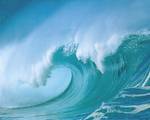
Weird ocean life surprises
By Dr David Whitehouse
BBC News Online science editor
New species of underwater life, including a giant sea spider and armoured shrimps, have been discovered by a expedition trawling in deep water northwest of New Zealand.
Behold fangtooth
Researchers on a joint NZ and Australian voyage also found deep-sea sponges and a prickly shark.
The scientists have just returned from four weeks aboard the Research Vessel Tangaroa collecting and photographing species at depths up to 2.1 kilometres (1.3 miles).
According to Mark Norman, of Victoria Museum in Australia, the survey around Lord Howe and Norfolk Islands was the most complex research expedition ever conducted in Australasia.
"Many species new to science were recognised, including new sharks and rays, redfish, rattails, and a range of invertebrates," he says.
Each way bet
The wonky-eyed squid
One newly discovered creature, called the fangtooth, has teeth longer than its head. To avoid piercing its own brain when it shuts its mouth, its teeth fit into opposing sockets.
The so-called viperfish has a hinged head and the coffinfish walks along the sea floor on short leg-like fins with a glowing lure on its head to attract prey.
They also found two rare spiked dogfish, a small type of shark, doubling the number of known specimens.
One of the strangest creatures was a Pacific spookfish which has a long snout that probes for electrical signals from its prey.
New species of armoured shrimps were found
There was also a squid, nicknamed the wonky-eyed jewel squid, which has a left eye much larger than its right eye. It seems that the big eye looks up for food while the small eye looks down for predators.
The spiders found on the sea floor are not related to terrestrial spiders. They have such small bodies that some of their internal organs are pushed down inside their hollow legs.
Work starts here
The strange characteristics of the new lifeforms are adaptations to conditions beneath kilometres of water where the pressure is hundreds of times greater than at the surface; and it is also completely dark.
The researchers also found a huge fossilised tooth of an extinct shark known as a megalodon. The tooth had been lying undisturbed on the sea floor for millions of years.
In total, 500 species of fish and 1,300 of invertebrates were discovered. It will take over a year to classify them all.
A spider but not as we know it
"We are only just beginning to understand our marine environment and voyages like this help us fill in pieces of the puzzle," says Australia's National Oceans Office deputy director Sean Sullivan.
"Scientists know roughly as much about Australia's ocean environments as we did about the Australian land 150 years ago."
The month-long voyage on the RV Tangaroa also found extinct volcanoes as they mapped the ocean floor during the 10,000-kilometre (6,200 miles) voyage.
Just another example of marine biodiversity that we never knew existed
STOP bottom trawling.





































